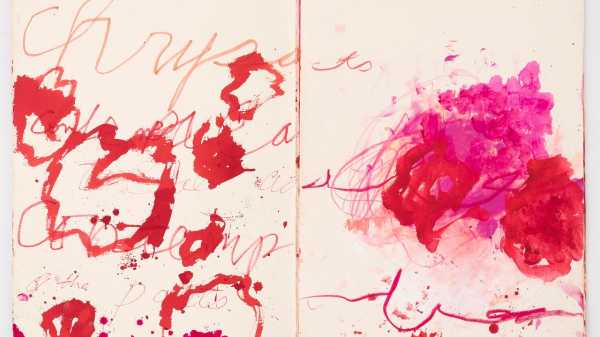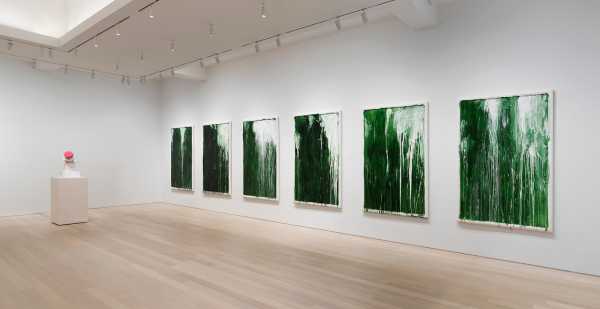
Cy Twombly put so much effort into hiding his talents that it’s no wonder the art world took ages to appreciate them. Between the early fifties and his death, in 2011, he tried very hard to seem not to be trying too hard, and his work betrays all the delights and headaches of the paradox. He was one of the best-read American painters of his time, but the literary allusions in his work are often misquoted and sometimes misspelled. His trademark loops and scribbles dare you to groan “juvenilia,” but, as a young artist living in Georgia, he spent nights alone in a dark room, teaching himself to draw without the meddling of his eyes. Unlearning is still a kind of learning.
In his career, as in his individual art works, Twombly practiced a disciplined indifference. Though he received a thorough technical education, beginning when he was a fourteen-year-old in Lexington, Virginia, attending lectures by the Catalan painter Pierre Daura, he didn’t come into his own until he attended Black Mountain College, in North Carolina, where intuition trumped technique. He spent time in New York, but left for Rome in 1957, right when it became clear that New York was the place to be. While his friends Jasper Johns and Robert Rauschenberg were rewarded for basking in their country’s gaudy present, he made Europe’s past his subject, and was mocked by American tastemakers eager to shrug off the Old World for good. He gave few interviews, and seemed to treat the ones he did as opportunities to flex his imagination. In 1994, the year of his first retrospective at the Museum of Modern Art, he invited Edmund White to his home in Gaeta, Italy. In the long Vanity Fair profile that came out about their time together, he claims his parents were Sicilian ceramicists.
They weren’t, actually, but the fib reveals more than the facts. Twombly is always sketching cheerfully bogus pasts and then scurrying off before he’s filled in the details. The new exhibition of his late work at Gagosian’s Madison Avenue gallery includes a a painting that features the word “PSILAX” (another name for the god Bacchus, from the Doric Greek for “winged”) with no elaboration, and a nineteen-year-old bronze, covered in what looks like centuries of tarnish. Other evocations of the past are subtler. The lines in his drawings and paintings don’t end; they trail off as though faded by sun or water. Look closer and you’ll find fainter marks, half erased or sloppily covered up, leaving What Is to muddle around in the filth of What Used to Be.
On paper, this might sound too smugly conceptual for its own good, but part of Twombly’s appeal lies in his awareness that filth can be beautiful, too. Say what you like about mold, rust, rot, smears, verdigris, and other kinds of colorful mutant residue, but there’s nothing precious about them. They don’t need anything from us, and that, under the right circumstances, makes their beauty more startling. Twombly’s favorite trick (earned with all those nights drawing in the dark) was to fill his images with fraying, melting lines that insinuated decay without being too pompous or too fussy. When the high-wire act succeeded, the results could be spectacular. In six large untitled acrylic paintings at Gagosian, all dated between 2002 and 2003, white dribbles down a field of thick, overripe green. The pigment responsible, Hooker’s Green, is often used for foliage, but here it’s hard not to think of guano caked to old bronze. Not that Twombly makes you choose between one association and the other. He wants you to keep both in your head at the same time, until decaying starts to seem like a kind of flourishing, which, given enough time, it is—one generation’s filth becomes the next generation’s fertilizer. At the bottom of each canvas, the same Hooker’s Green, once the native and now the messy intruder, stains the wooden frame. All things, even a forest or a Greek vase, were dribbles once, and unto dribbles shall they return.

The new exhibition of Twombly’s work at Gagosian’s Madison Avenue gallery.
Art works © Cy Twombly Foundation / Photograph by Robert McKeever / Courtesy Gagosian
Twombly may be the most palpably content painter in the American canon. This is a strange claim to make about someone whose work is full of death and destruction, but, because he tends to think in centuries, the destruction feels innocent in its universal sweep, gentle in its hints of renewal. (There are no graves in these pictures without a few flowers poking out.) When he tries human-scale violence, as in the early milestones “Leda and the Swan” and “Death of Pompey” (both 1962), the hazy strokes, with their murmurs of historical remove, soften the sting. The violence in “Untitled” (2007), with its double whammy of blood-red swirls and shrill yellow field, is hard to miss, but the longer you look the less permanent it seems: the faded reds in the background reassure you that this has happened before and can be weathered again. Sensual pleasure suffers no equivalent dip in intensity. Bright reds advertise fruit, flowers, and wine, but so do the waterier reds, pinks, and purples in “Untitled (Contemplation of the Chrysanthemum),” a series of drowsy, sun-drunk works on paper, which Twombly produced between 1984 and 2002. In the struggles that he stages between pleasure and pain, pleasure rarely wins by knockout, but it wins.
This can get predictable. When Twombly is at his best, as he is for a good chunk of this exhibition, his creations have an easygoing charm, as though they weren’t really looking for the sublime but are tickled to have found it anyway. His untitled painting of loops of brown (2005) has no charm in reproduction, but when seen face to face it sings: beneath the brown, a faint membrane of blue gives the composition a gentle, humming mystique. (One explanation for why Twomblys attract such high prices today, assuming there’s ever any logic behind such things, is that the only way to enjoy many of them is to stand in front of them.) But there are also a fair number of times when Twombly’s contentment just seems insipid. The little trio of floral acrylic paintings (all 2003) on the lower floor is too repetitively cheery to be engaging, like a bad series of children’s books. Without much drama to spice things up, the deliberate sloppiness of the thin brushstrokes suggests a facile confidence that’s hard to admire, let alone share.
“I’m not too sensitive to color,” Twombly told the former Tate director Nicholas Serota, in 2008—another fib, maybe, or maybe not. He’s masterly at constructing long, twisty arias for single pigments, but harmony isn’t his thing. In his works on paper from the early two-thousands, color seems to start over with each stroke, scratch, or blotch. Tart oranges, blues, reds, and greens interrupt each other mid-sentence, and the final thickets of color are never half as arresting as they look at first sight. There are other works at Gagosian in which Twombly overcomes his limitations, most ravishingly the two “Winter Pictures” (2004): flashes of a New England evening in spindly pillars of black, gray, blue, and peach, brought to you by a man who spent decades by the Mediterranean. Much of the time, though, Twombly’s colors have an arbitrary feel, with plenty of rich flavor but no aftertaste; you’re not always convinced that it had to be this blue, or any blue at all. Near the “Winter Pictures” are two similarly sized, untitled paintings, both covered in bloated chicken scratch. They’d be hard to tell apart if not for the fact that one has a deep purple field and the other deep brown. “Purple, brown,” Twombly seems to shrug. “Why not both?”
Still, it’s an artist’s privilege to equivocate, leaving viewers to bicker and scuffle. Around the time of Twombly’s MoMA retrospective, Artforum published a pair of duelling essays by Rosalind Krauss and Peter Schjeldahl. Schjeldahl saw in Twombly a shallow but sincere nostalgia for Mediterranean history; for Krauss, his bottomless classicism and name-dropping parody the attitudes they seem to echo. Both sides have their fans, though Schjeldahl seems to have proved more influential; one reason there aren’t even more classics-infused art works in this exhibition is that they’re hanging in the Museum of Fine Arts, Boston, as part of a show that examines Twombly’s romance with antiquity. This gives the classical allusions at Gagosian a starkness that makes them seem sillier at times but more heartfelt at others. In one untitled canvas, from 2004, the word “BACCHUS” cowers in the corner, the “B” looking like it was drawn by someone who learned how an hour ago—a precocious Southern kid’s daydream of Europe, all the more endearing for being half-baked.
The U.S. has never lacked for breathless Europhiles, even if Europhobia is one of the country’s favorite kinds of comedy. (A sliver of the South, Twombly told White, has more columns than ancient Rome and ancient Greece put together.) It strikes me that, on this matter, as with so many others, Twombly opted to split the difference. His sheepish Europhilia announces itself and then cracks a joke to lighten the mood. Crudeness wraps itself in erudition like two kids in a trenchcoat. Long before it was fashionable to talk about “provincializing Europe,” his art poked gentle fun at the grandeur of gods and ruins, but not without whipping up some grandeur of its own: a priceless old statue may be only rust, really, but what’s so bad about rust? As a young man, Twombly’s fixations seemed out of step with the times, though nowadays—when American painters like Kehinde Wiley look back on Western culture with a mixture of fascination and irreverence—his fidgeting with antiquity seems like the most urgently present-tense thing about him.
How much fascination with the past is too much? How much irreverence? At a time when Western heritage is likely to be treated either as an albatross or a flawless heirloom, Twombly looks refreshingly balanced. He’s smart enough to see through the past but is seduced all the same, and he takes pleasure in seducing you, too. “Scent of a Rose” (2000) is preposterous in almost every way a sculpture can be: the short stack of irregular shapes won’t stand straight, even with a doorstop sticking out of one side; white paint tries to look fancy but can’t hide the texture of rough wood; there’s a piece of paper stapled to the middle and red paint smeared where it doesn’t belong; one side of the base isn’t painted at all. Even if you know better, though, the dirty white slab may give you a little twinge of reverence for the past, as though “Scent of a Rose” were twenty-three hundred years old instead of twenty-three. Twombly’s best art always provokes that twinge. Maybe we should question the feeling more often, or maybe savor it, but sometimes the wisest thing an artist can do is shrug and ask, “Why not both?” ♦
Sourse: newyorker.com






